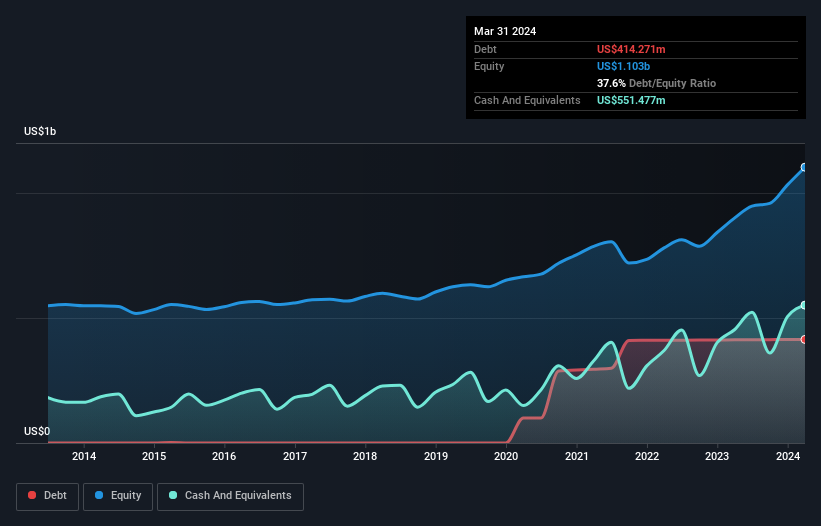David Iben put it well when he said, 'Volatility is not a risk we care about. What we care about is avoiding the permanent loss of capital.' So it might be obvious that you need to consider debt, when you think about how risky any given stock is, because too much debt can sink a company. We note that Stride, Inc. (NYSE:LRN) does have debt on its balance sheet. But should shareholders be worried about its use of debt?
Why Does Debt Bring Risk?
Debt is a tool to help businesses grow, but if a business is incapable of paying off its lenders, then it exists at their mercy. If things get really bad, the lenders can take control of the business. However, a more frequent (but still costly) occurrence is where a company must issue shares at bargain-basement prices, permanently diluting shareholders, just to shore up its balance sheet. Having said that, the most common situation is where a company manages its debt reasonably well - and to its own advantage. The first step when considering a company's debt levels is to consider its cash and debt together.
View our latest analysis for Stride
How Much Debt Does Stride Carry?
The chart below, which you can click on for greater detail, shows that Stride had US$414.3m in debt in March 2024; about the same as the year before. But on the other hand it also has US$551.5m in cash, leading to a US$137.2m net cash position.

How Strong Is Stride's Balance Sheet?
According to the last reported balance sheet, Stride had liabilities of US$282.0m due within 12 months, and liabilities of US$507.0m due beyond 12 months. On the other hand, it had cash of US$551.5m and US$577.8m worth of receivables due within a year. So it can boast US$340.3m more liquid assets than total liabilities.
This short term liquidity is a sign that Stride could probably pay off its debt with ease, as its balance sheet is far from stretched. Succinctly put, Stride boasts net cash, so it's fair to say it does not have a heavy debt load!
In addition to that, we're happy to report that Stride has boosted its EBIT by 55%, thus reducing the spectre of future debt repayments. When analysing debt levels, the balance sheet is the obvious place to start. But ultimately the future profitability of the business will decide if Stride can strengthen its balance sheet over time. So if you want to see what the professionals think, you might find this free report on analyst profit forecasts to be interesting.
Finally, a company can only pay off debt with cold hard cash, not accounting profits. Stride may have net cash on the balance sheet, but it is still interesting to look at how well the business converts its earnings before interest and tax (EBIT) to free cash flow, because that will influence both its need for, and its capacity to manage debt. Over the last three years, Stride recorded free cash flow worth a fulsome 86% of its EBIT, which is stronger than we'd usually expect. That positions it well to pay down debt if desirable to do so.
Summing Up
While it is always sensible to investigate a company's debt, in this case Stride has US$137.2m in net cash and a decent-looking balance sheet. And it impressed us with free cash flow of US$141m, being 86% of its EBIT. So we don't think Stride's use of debt is risky. Another factor that would give us confidence in Stride would be if insiders have been buying shares: if you're conscious of that signal too, you can find out instantly by clicking this link.
Of course, if you're the type of investor who prefers buying stocks without the burden of debt, then don't hesitate to discover our exclusive list of net cash growth stocks, today.
New: Manage All Your Stock Portfolios in One Place
We've created the ultimate portfolio companion for stock investors, and it's free.
• Connect an unlimited number of Portfolios and see your total in one currency
• Be alerted to new Warning Signs or Risks via email or mobile
• Track the Fair Value of your stocks
Have feedback on this article? Concerned about the content? Get in touch with us directly. Alternatively, email editorial-team (at) simplywallst.com.
This article by Simply Wall St is general in nature. We provide commentary based on historical data and analyst forecasts only using an unbiased methodology and our articles are not intended to be financial advice. It does not constitute a recommendation to buy or sell any stock, and does not take account of your objectives, or your financial situation. We aim to bring you long-term focused analysis driven by fundamental data. Note that our analysis may not factor in the latest price-sensitive company announcements or qualitative material. Simply Wall St has no position in any stocks mentioned.
About NYSE:LRN
Stride
Provides proprietary and third-party online curriculum, software systems, and educational services in the United States and internationally.
Very undervalued with flawless balance sheet.
Similar Companies
Market Insights
Community Narratives



